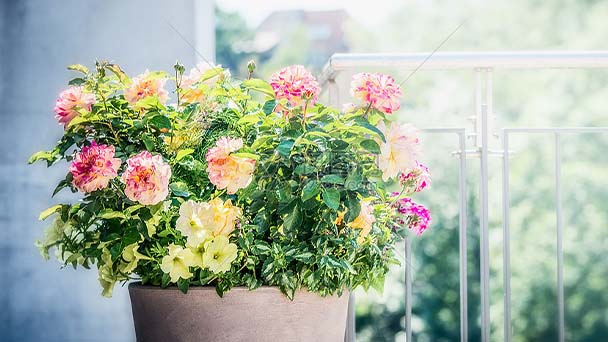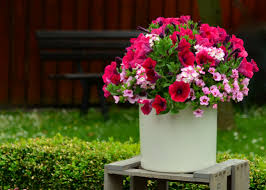Suggestions about how to do container gardening
Written by Joy
Sep 29 2020

How to do container gardening? Container gardens are an easy way to add color to tight spots on your garden or porch. And it is not as simple as throwing some begonias and impatiens in the pot. You need to pay attention to the plants you are pairing in the container. Some plants grow well in sunlight and shade, while others are more picky in their preferred light and water requirements. This article is mainly about how to do container gardening.

Terracotta Warriors: Clay pots have multiple uses and are inexpensive. This is why they are so common in gardens. The only disadvantage of using clay is that the clay material cannot withstand freezing temperature.
10" to 12" pot can hold 3-6 plants
Pots from 14" to 16" can hold 4-8 plants
16" to 20" pot can hold 6-12 plants

How to choose a containerConcreteWoodMetalPlastic or polyurethane foamRepurposed containersStandard plant container sizeThrillersFillingSpillerPlanting and maintaining container gardens
How to choose a container
There are many things to consider when choosing a container (budget, space and style, to name a few). Just like plants, containers have their own characteristics: weight, sensitivity to weather changes and appearance. These are the common types of flower pots you might choose when doing container gardening.Terracotta Warriors: Clay pots have multiple uses and are inexpensive. This is why they are so common in gardens. The only disadvantage of using clay is that the clay material cannot withstand freezing temperature.
Concrete
Concrete containers can withstand any type of weather. You'd better be careful when placing concrete flower pots because they are very heavy and harder to move once they are filled with soil and plants.Wood
It's a better choice to choose solid wood, such as cedar or non-toxic treated pine. For safety, please wash all wood surfaces with waterproof liquid while doing your container gardening.Metal
Galvanized bathtubs and buckets are great choices for container gardens. However, you should be aware that when using metal containers, plants will quickly become hot. To protect the plants, you could align the container with the garden fabric and place it in the shade while doing container gardening.Plastic or polyurethane foam
These types of containers can look like any other types of containers. They are not of high quality and will not exist forever, but they can achieve a certain appearance.Repurposed containers
You ought to choose old baskets, iron buckets, bird baths, and watering containers to hold your favorite plants. The exquisite appearance is stylish and rustic.Standard plant container size
You should be careful not to overfill the container garden. If the plants are overcrowded, growth can be stunted above and below the soil. You usually want to follow these tank size ratios:10" to 12" pot can hold 3-6 plants
Pots from 14" to 16" can hold 4-8 plants
16" to 20" pot can hold 6-12 plants
How to choose plants for container gardens?
There is a rule of thumb when choosing different combinations of plants in a container: there are thrillers, fillers and fillers. Combining these three plants can add interest and balance to any container garden.Thrillers
Thrillers are plants that highly add dramatic and vertical elements. Some options include foliage plants, ornamental grasses or upright flowering plants. Thrillers usually enter the center of the gardening container.Filling
Fillings are often more round or tamped plants whose purpose is to make the container look full. These are usually placed in front of or around the thriller. In a long, narrow container like a window box, the filler is placed in the middle between the edge of the container and the thriller.Spiller
Trailing plants hanging from the edge of the planter are considered spills. If you want to observe the container from all sides, you should make sure to place sprinklers on all sides.Planting and maintaining container gardens
Before adding soil or plants, add rocks to the bottom of the container to aid drainage. It's better to use potting soil Because garden soil is heavy and compact, potting soil makes it easier to drain the container while retaining moisture. Container gardens are easier to dry than underground gardens, so any extra moisture will help plants stay happy. You should make sure that the container is sterilized to eliminate the chance of fungi and bacteria spreading to the plants. Watering the container garden in the early morning or evening is suitable. If the first inch or so of the soil is dry, you need to water it.Latest Updated
- Benefits of Bugleweed - 7 Science-backed Health Benefits
- Bugleweed Dangers & Side Effects - Is It Poisonous?
- How to Plant Evergreen Trees - What You Should Know
- When to Plant Evergreens - Grow Guide for Evergreen Trees
- 12 Wonderful Evergreen Shrubs for Your Garden
- 12 Popular Evergreen Plants with Pictures for Beginners
- When And How To Prune A Lilac Bush Like a Pro
- How to Grow & Care for Lilac Vine (Hardenbergia Violacea)
- Japanese Lilac Tree (Syringa Reticulata) Care & Propagation Guide
- Shumard Oak Pros and Cons - What to Know
Popular Articles
- Winter maintenance of Antirrhinum Majus
- How to Grow Terminalia Mantaly Tree
- How to Grow and Care for Crossostephium Chinense
- How to grow Antirrhinum Majus in spring
- Peristeria Elata (Dove Orchid) Profile: Info & Care Guide
- Underwatered Snake Plant (Sansevieria Trifasciata) - Signs And How To Fix
- How to Care for Brazilian Jasmine Plant (Mandevilla Sanderi)
- How to Grow & Care for Graptopetalum Purple Delight in Summer
- Rosa Chinensis (China Rose): Plant Growing & Care Tips
- How to Care for Baby Sun Rose (Aptenia Cordifolia)